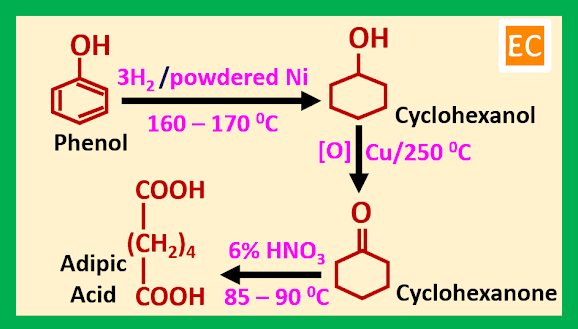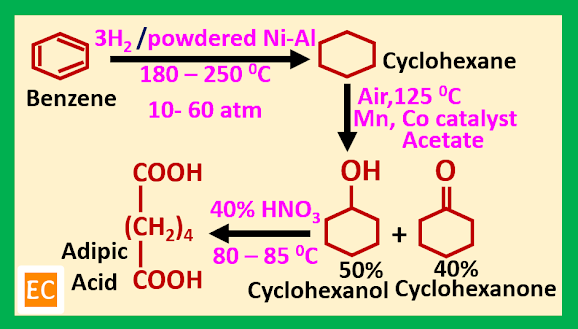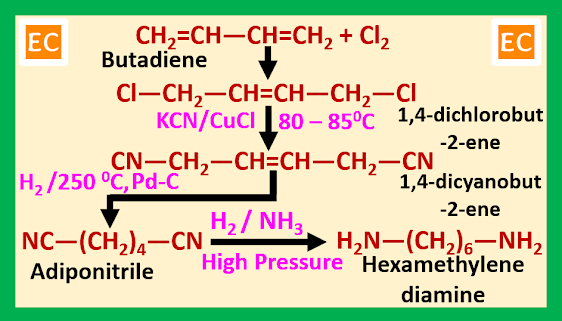Nylon 6.6
Nylon 6.6 is a diamine-dibasic acid polymer. Nylon 6.6 is generally prepared by the reaction of hexamethylene diamine [H2N―(CH2)6―NH2] and adipic acid [HOOC―(CH2)4―COOH]. In nylon 6.6 first 6 indicates the number of carbon atoms in the hexamethylene diamine part and second 6 indicates the number of carbon atoms in the adipic acid part. Since this polyamide contain 6 carbon atoms in the first part and 6 carbon atoms in the second part, so, it is nylon 6.6.
Manufacture of Adipic Acid
Adipic acid is prepared by various synthetic methods. Among these various synthetic methods, two such methods are----
Synthetic Method – 1
Adipic Acid from Phenol
Reaction of phenol with hydrogen in presence of powdered Ni catalyst at 160 – 170 0C formed cyclohexanol. Oxidation of cyclohexanol in presence of Cu at 250 0C produced cyclohexanone. When cyclohexanone treated with 6% HNO3 at 85 – 90 0C adipic acid is formed.
Synthetic Method – 2
Adipic Acid from Benzene
Reaction of benzene with hydrogen in presence of powdered Raney Ni catalyst at 180 – 250 0C and at 10 – 60 atm formed cyclohexane. Oxidation of cyclohexane in presence of air at 125 0C and in presence of Mn, Co catalyst produces cyclohexanol and cyclohexanone. When this mixture of products reacted with 40% HNO3 at 80 – 85 0C adipic acid is formed.
Manufacture of Hexamethylene diamine
Hexamethylene diamine is prepared by various synthetic methods. Among these various synthetic methods, three such methods are----
Synthetic Method – 1
Hexamethylene diamine from Butadiene
Reaction of butadiene with chlorine produced 1,4-dichlorobut-2-ene. When this 1,4-dichlorobut-2-ene treated with KCN in presence of CuCl at 80 – 85 0C 1,4-dicyanobut-2-ene is formed. Reaction of 1,4-dicyanobut-2-ene with hydrogen in presence of Pd-C produced adiponitrile. When adiponitrile treated with hydrogen at high pressure in presence of NH3 hexamethylene diamine is formed.
Synthetic Method – 2
Hexamethylene diamine from Adipic Acid
Reaction of adipic acid with NH3 at 350 – 400 0C in silica gel produced adipamide. This adipamide heated to formed adiponitrile. Reaction of adiponitrile with hydrogen in presence of NH3 at high pressure produced hexamethylene diamine.
Synthetic Method – 3
Hexamethylene diamine from Acrylonitrile
Reaction of acrylonitrile with hydrogen at law pressure produced adiponitrile. When adiponitrile treated with hydrogen in presence of Co-Cu at 100 – 135 0C produced hexamethylene diamine.
Manufacture of nylon 6.6
Adipic acid and hexamethylene diamine both are soluble in water. So, aqueous solution of both reactants is mixed in 1:1 molar ratio, and maintain 7.8 PH of the mixture. The solution is evaporated under vaccum. 0.5 – 1 % mole of CH3COOH as viscosity and molecular weight stabilizer is added to the liquid residue, and the liquid residue charged to an autoclave under 250 poise pressure and heated at about 270 – 280 0C. Vaccum is applied after some progress of the reaction to facilitate to release and removal of the rest water from the reaction zone. After 3 – 4 hours, the process has been completed. By a nitrogen pressure of 40 -50 poise, the molten polymer is extruded through the bottom of the autoclave as a ribbon with molecular weight ranging between 12000 – 16000, which after cooling by water and air in the particular stages, is cut into cubes of regular sizes.
Properties of nylon 6.6
Nylon 6.6 is tough, strong, and elastic in nature. Nylon 6.6 possess high tensile strength and abrasion resistance. Its moisture resistance is very good and it maintain its elasticity upto 150 0C. Melting point of nylon 6.6 is 263 0C in nitrogen and in air is 250 0C. Specific gravity of nylon 6.6 is 1.14. Strength and abrasion resistance of nylon 6.6 is high and it maintain its toughness upto 150 0C and its solvent resistance is good. Nylon 6.6 attacked by air or water at elevated temperature and it is opaque to sunlight. In sunlight nylon 6.6 undergoes fading in colours.

















No comments:
Post a Comment